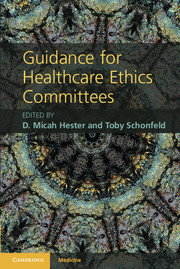Book contents
- Frontmatter
- Contents
- Contributors
- Preface
- Section 1 The Context of Healthcare Ethics Committee Work
- Section 2 Consultation
- 5 Mission, vision, goals: defining the parameters of ethics consultation
- 6 Ethics consultation process
- 7 Informed consent, shared decision-making, and the ethics committee
- 8 Decision-making capacity
- 9 Family dynamics and surrogate decision-making
- 10 Confidentiality
- 11 Advance care planning and end-of-life decision-making
- 12 Medical futility
- 13 Ethical issues in reproduction
- 14 Ethical issues in neonatology
- 15 Ethical issues in pediatrics
- Section 3 Policy Development and Organizational Issues
- Section 4 Educating Others
- Index
- References
9 - Family dynamics and surrogate decision-making
Published online by Cambridge University Press: 05 August 2012
- Frontmatter
- Contents
- Contributors
- Preface
- Section 1 The Context of Healthcare Ethics Committee Work
- Section 2 Consultation
- 5 Mission, vision, goals: defining the parameters of ethics consultation
- 6 Ethics consultation process
- 7 Informed consent, shared decision-making, and the ethics committee
- 8 Decision-making capacity
- 9 Family dynamics and surrogate decision-making
- 10 Confidentiality
- 11 Advance care planning and end-of-life decision-making
- 12 Medical futility
- 13 Ethical issues in reproduction
- 14 Ethical issues in neonatology
- 15 Ethical issues in pediatrics
- Section 3 Policy Development and Organizational Issues
- Section 4 Educating Others
- Index
- References
Summary
Objectives
Explain the concept and moral foundations of surrogate decision-making.
Describe the ethical and legal criteria for choosing a surrogate and for surrogate decision-making.
Identify classic ethical dilemmas of surrogate decision-making, for example: family stake in treatment decisions, reliability of surrogate decision-makers, potential conlicts between possible surrogates, and between surrogates and care providers.
Case
Mr. D was a 57-year-old man with a history of schizoaffective disorder and drug abuse who presented to the emergency department with a diffuse painful maculopapular rash, blistering of his mouth, sloughing of skin at the tip of his nose and a temperature of 104 degrees. He required urgent intubation due to extensive oropharyngeal involvement and an increasing oxygen requirement in the emergency department. He was admitted to the burn intensive care unit and diagnosed with drug-induced toxic epidermal necrolysis caused by a new psychiatric medication that was begun severalweeks prior to his presentation. His rash involved 95 percent of his body including his mucous membranes and his eyes.
His hospital course was complicated bywound infection, sepsis requiring pressors, hypotension, acute renal failure, and severe pain, particularly with dressing changes. He had a prolonged stay in the intensive care unit and remained ventilator dependent. His prognosis based on his presentation, including the extent of skin involvement and subsequent complications, was poor. His mortality was estimated at greater than 75 percent and, even if he survived a several month intensive care unit stay, he would require a lengthy, painful rehabilitation course and likely lifelong assistance with care either at a facility or with care providers in his home.
- Type
- Chapter
- Information
- Guidance for Healthcare Ethics Committees , pp. 63 - 70Publisher: Cambridge University PressPrint publication year: 2012

